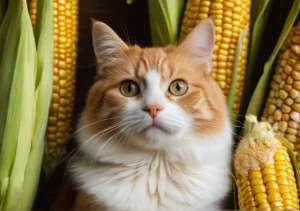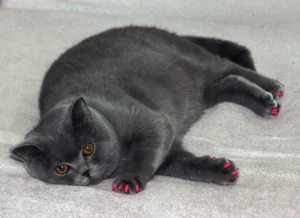Disclosure: We may earn a commission from helpful, relevant links in our content. No cost to you. See our privacy policy.

Discovering your purr-fect companion has diabetes can feel like you’re navigating through a furball of confusion. After all, Mr. Whiskers deserves nothing but the best, especially when it comes to his diet.
In this blog post, you’ll be equipped with the essential intel on choosing the best dry cat food for your diabetic feline friend – because they deserve to meow in happiness, not in hunger.
Quick Takeaways:
- Choose high-protein, low-carbohydrate dry cat food to better manage your diabetic cat’s blood sugar levels.
- Avoid cat foods with high carbohydrates and fillers like corn and wheat to prevent blood sugar spikes.
- Gradually introduce new food over a week or two, monitoring your cat’s health and consulting your vet for personalized advice.
What Makes Cat Food Great for Diabetic Cats?
When you’ve got a diabetic whisker baby at home, picking the right chow is more crucial than ever. For these special furballs, high protein and low carbohydrate content isn’t just beneficial; it’s a must.
Diabetic cats need a diet that mimics what they’d naturally munch on – minus the mouse, of course. A high protein content helps maintain muscle mass, which is vital since diabetes can often lead to muscle wasting. But why go low on carbs? Simple. Cats aren’t made to process a lot of carbohydrates. In diabetic cats, minimizing carb intake can help stabilize blood glucose levels, making their condition easier to manage.
Then there’s fiber – the unsung hero of a diabetic cat’s diet. Fiber slows the absorption of sugar into the bloodstream, preventing those unwanted spikes in blood glucose. But, like all good things, moderation is key. Too much fiber can lead to other issues, like constipation or not enough nutrient absorption.
If you’re wondering what exactly to look for, meats or meat by-products should be at the top of the ingredients list, with minimal fillers or grains further down. Remember, the goal is to mimic their natural dietary habits as closely as possible.
How Can the Right Dry Food Help Manage Diabetes?
Choosing the right dry food for your diabetic cat can be a game-changer. The ideal diet can do wonders, from stabilizing blood sugar levels to potentially reducing the need for insulin injections. Yes, you heard that right. With a properly managed diet, some cats can even experience remission from their diabetes. That’s not to say they’re cured – diabetes is a lifelong condition – but it means they may not need daily insulin shots for the time being.
Stable blood sugar levels also mean a happier, more energetic cat. Diabetic cats on the wrong diet can often seem lethargic or out of sorts. The right food can help them regain their mojo and live fuller, healthier lives.
Let’s not forget about the long haul. Managing your cat’s diabetes effectively with the right diet can also reduce the risk of complications associated with the disease, like neuropathy or kidney issues. It’s all about giving them the best shot at a healthy life, insulin or no insulin.
What Should You Avoid in Dry Cat Food for Diabetic Cats?
Alright, folks, here’s the skinny on what to avoid when you’re perusing the cat food aisle for your diabetic companion:
- High carbohydrates: This one’s a no-brainer. High-carb diets can wreak havoc on your cat’s blood sugar levels. Look for foods that boast a low glycemic index.
- Fillers like corn and wheat: Fillers are often just empty calories. They don’t provide much nutritional value and can spike blood sugar levels. Stick to foods where meat is the main ingredient.
- Certain preservatives: While not all preservatives are bad, some, like BHA and BHT, can be questionable. Opt for cat food with natural preservatives, like vitamins C and E (tocopherols).
Here’s a pro tip that’s often overlooked: Pay attention to the food’s texture. Diabetic cats can sometimes be pickier eaters, and palatability becomes even more crucial. It’s not just about what’s in the food but how it’s presented. Some diabetic cats prefer crisper kibble, as it provides a satisfying crunch.
In essence, managing your diabetic cat’s condition isn’t just about monitoring their insulin; it’s also about what goes into their bowl every day. Armed with this knowledge, you’re now better equipped to make informed decisions about your feline friend’s diet, steering them towards a happier and healthier life. Let’s give our diabetic whisker kids nothing but the best.
How to Transition Your Diabetic Cat to a New Dry Food?
Switching your diabetic cat to a new dry food isn’t something to leap into without a bit of prep. You see, cats, much like us when trying a radical new diet, might turn their noses up at the unfamiliar or might have a bit of a tummy grumble if things move too quickly. Here’s a step-by-step guide to ensure the switch is as smooth as silk:
-
Start with a blend: Begin by mixing a small amount of the new food in with their current one. Think of it as easing them into the pool rather than tossing them into the deep end. Start with a ratio of 75% old food to 25% new food, and over the next week or two, gradually increase the amount of new food.
-
Keep an eye on them: Just like a hawk! Monitor your cat’s reaction to the new food closely. Any signs of digestive upset, reluctance to eat, or changes in their blood glucose levels should be noted and discussed with your vet.
-
Steady as she goes: Don’t rush the process. Each step of increasing the new food portion should last a few days at least. Your cat’s comfort and health are the top priority, and some cats might need more time to adjust than others.
-
Hydration station: Diabetic cats especially need to stay well-hydrated, so make sure fresh water is always available, especially as they adjust to the new food which may have a different moisture content than they’re used to.
-
Consult the experts: Throughout this process, keep in regular contact with your vet. They can offer personalized advice and help monitor your cat’s health during the transition.
Top Picks: The Best Dry Cat Food for Diabetic Cats
Navigating the sea of dry cat food options for your diabetic fur baby can feel like looking for a needle in a haystack. You want something low in carbohydrates, high in protein, something that tastes so good they’ll think it’s Christmas. Without further ado, here are the top picks that tick all these boxes and then some:
1. Hill’s Prescription Diet m/d Glucose/Weight Management Cat Food
Why it’s great: Hill’s is a trusted brand recommended by vets, and their m/d range is specifically formulated for diabetic cats. It’s high in protein and low in carbs, striking just the right balance to support your cat’s blood sugar levels and maintain a healthy weight. Plus, it contains L-carnitine to help turn fat into energy and increase lean muscle mass.
2. Purina Pro Plan Veterinary Diets DM Dietetic Management
Standout features: This option from Purina is another heavyweight contender in the ring of diabetic cat care. It boasts a high-protein, low-carb formula designed to manage diabetes while ensuring your cat stays well-fed and satisfied. What’s more, it’s enriched with antioxidants to support a healthy immune system.
3. Royal Canin Veterinary Diet Glycobalance
Why choose it: Royal Canin is another brand with a stellar reputation among vets. Their Glycobalance formula is crafted with a precise blend of fibers and proteins to help manage postprandial blood glucose levels—a fancy way of saying it helps keep your cat’s blood sugar stable after meals. Its moderate calorie content also aids in maintaining an ideal body weight.
Unique Tip: Look for Foods with Functional Ingredients
One thing often overlooked when choosing diabetic cat food is the presence of functional ingredients—those added for a specific health purpose beyond basic nutrition. For example, foods containing omega-3 fatty acids can support glucose metabolism and may have anti-inflammatory benefits. An example here is Blue Buffalo Wilderness High Protein Grain-Free Dry Cat Food which, in addition to being high in protein and low in carbs, also contains life-source bits packed with antioxidants, vitamins, and minerals to support overall health.
By considering these options, you’re taking a solid step toward managing your cat’s diabetes through diet. Remember, always introduce new foods gradually and under the guidance of your vet, keeping a close eye on how your kitty responds. With patience and care, you’ll find the perfect match for your feline friend’s nutritional needs, helping them lead a happy, healthy life even with diabetes.
Alex, a passionate animal lover, has experience in training and understanding animal behavior. As a proud pet parent to two dogs and three cats, he founded AnimalReport.net to share insights from animal experts and expand his knowledge of the animal kingdom.




